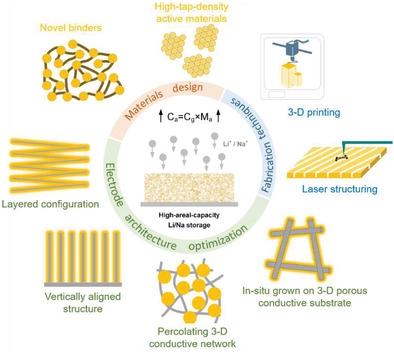 发表刊物:Advanced Energy Materials
摘要:In recent decades, extensive nanomaterials and related techniques have been proposed to achieve high capacities surpassing conventional battery electrodes. Nevertheless, most of them show low mass loadings and areal capacities, which deteriorates the cell-level energy densities and increases cost after the consideration of inactive components in batteries. Achieving high-areal-capacity is essential for those advanced materials to move out of laboratories and into practical applications, yet remains challenging due to the decreased mechanical properties and sluggish electrochemical kinetics at elevated mass loadings. In this paper, the previously reported strategies for promoting areal lithium storage performance, including material-level designs, electrode-level architecture optimization, and novel manufacturing techniques are reviewed. Sodium-ion battery electrodes are discussed subsequently, emphatically on its difference with those for lithium storage. Pouch-cell-level energy densities based on high-areal-capacity electrodes with different thicknesses are also estimated. For each category of these strategies, working principles, advantages, and possible problems are analyzed, with typical examples presented in detail and a summary table comparing the structures and achieved performance. Finally, the features of the high-areal-capacity electrodes demonstrated in this review are concluded, and overlooked issues and potential research directions in this field are summarized.
发表刊物:Advanced Energy Materials
摘要:In recent decades, extensive nanomaterials and related techniques have been proposed to achieve high capacities surpassing conventional battery electrodes. Nevertheless, most of them show low mass loadings and areal capacities, which deteriorates the cell-level energy densities and increases cost after the consideration of inactive components in batteries. Achieving high-areal-capacity is essential for those advanced materials to move out of laboratories and into practical applications, yet remains challenging due to the decreased mechanical properties and sluggish electrochemical kinetics at elevated mass loadings. In this paper, the previously reported strategies for promoting areal lithium storage performance, including material-level designs, electrode-level architecture optimization, and novel manufacturing techniques are reviewed. Sodium-ion battery electrodes are discussed subsequently, emphatically on its difference with those for lithium storage. Pouch-cell-level energy densities based on high-areal-capacity electrodes with different thicknesses are also estimated. For each category of these strategies, working principles, advantages, and possible problems are analyzed, with typical examples presented in detail and a summary table comparing the structures and achieved performance. Finally, the features of the high-areal-capacity electrodes demonstrated in this review are concluded, and overlooked issues and potential research directions in this field are summarized.